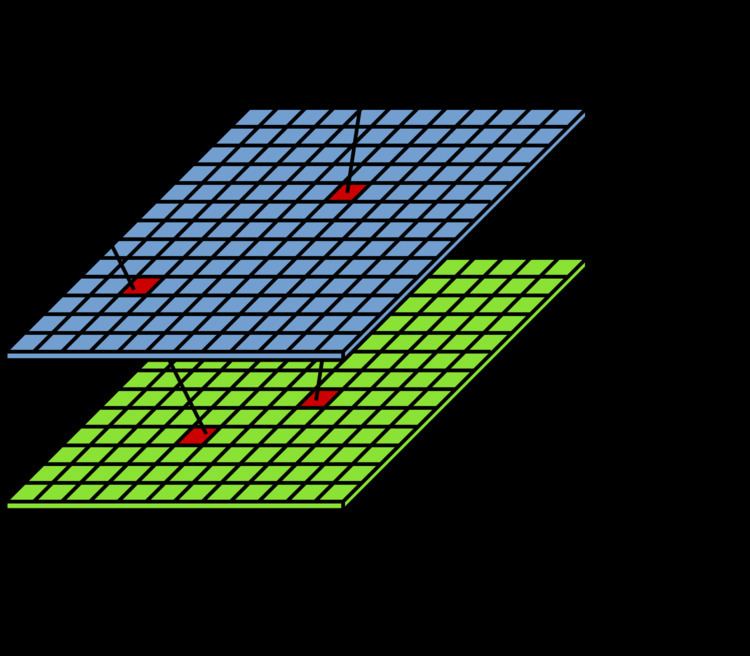 | ||
The BaBar experiment, or simply BaBar, is an international collaboration of more than 500 physicists and engineers studying the subatomic world at energies of approximately ten times the rest mass of a proton (~10 GeV). Its design was motivated by the investigation of Charge Parity violation. BaBar is located at the SLAC National Accelerator Laboratory, which is operated by Stanford University for the Department of Energy in California.
Contents
Physics
BaBar was set up to understand the disparity between the matter and antimatter content of the universe by measuring Charge Parity violation. CP symmetry is a combination of Charge-conjugation symmetry (C symmetry) and Parity symmetry (P symmetry), each of which are conserved separately except in weak interactions. BaBar focuses on the study of CP violation in the B meson system. The name of the experiment is derived from the nomenclature for the B meson (symbol
B
) and its antiparticle (symbol
B
, pronounced B bar). The experiment's mascot was accordingly chosen to be Babar the Elephant.
If CP symmetry holds, the decay rate of B mesons and their antiparticles should be equal. Analysis of secondary particles produced in the BaBar detector showed this was not the case – in the summer of 2002, definitive results were published based on the analysis of 87 million
B
/
B
meson-pair events, clearly showing the decay rates were not equal. Consistent results were found by the Belle experiment at the KEK laboratory in Japan.
CP violation was already predicted by the Standard Model of particle physics, and well established in the neutral kaon system (
K
/
K
meson pairs). The BaBar experiment has increased the accuracy to which this effect has been experimentally measured. Currently, results are consistent with the Standard Model, but further investigation of a greater variety of decay modes may reveal discrepancies in the future.
The BaBar detector is a multilayer particle detector. Its large solid angle coverage (near hermetic), vertex location with precision on the order of 10 μm (provided by a silicon vertex detector), good pion–kaon separation at multi-GeV momenta (provided by a novel Cherenkov detector), and few-percent precision electromagnetic calorimetry (CsI(Tl) scintillating crystals) allow a list of other scientific searches apart from CP violation in the B meson system. Studies of rare decays and searches for exotic particles and precision measurements of phenomena associated with mesons containing bottom and charm quarks, as well as phenomena associated with tau leptons are possible.
The BaBar detector ceased operation on 7 April 2008, but data analysis is ongoing.
Detector description
The BaBar detector is cylindrical with the interaction region at the center. In the interaction region, 9 GeV electrons collide with 3.1 GeV antielectrons (sometimes called positrons) to produce a center-of-mass collision energy of 10.58 GeV, corresponding to the
ϒ
(4S) resonance. The
ϒ
(4S) decays immediately into a pair of B mesons – half the time
B+
B−
and half the time
B0
B0
. To detect the particles there are a series of subsystems arranged cylindrically around the interaction region. These subsystems are as follows, in order from inside to outside:
π0
)) and of "long Kaons" (
K
L), which are also electrically neutral.
Notable events
On 9 October 2005, BaBar recorded a record luminosity just over 1 × 1034 cm−2s−1 delivered by the PEP-II positron-electron collider. This represents 330% of the luminosity that PEP-II was designed to deliver, and was produced along with a world record for stored current in an electron storage ring at 1,732 mA, paired with a record 2,940 mA of positrons. "For the BaBar experiment, higher luminosity means generating more collisions per second, which translates into more accurate results and the ability to find physics effects they otherwise couldn’t see."
In 2008, BaBar physicists detected the lowest energy particle in the bottomonium quark family. Spokesman Hassan Jawahery said: "These results were highly sought after for over 30 years and will have an important impact on our understanding of the strong interactions."
In May 2012 BaBar reported that their recently analyzed data may suggest possible flaws in the Standard Model of particle physics. These data show that a particular type of particle decay called "B to D-star-tau-nu" happens more often than the Standard Model says it should. In this type of decay, a particle called the B-bar meson decays into a D or Dstar meson, an antineutrino and a tau-lepton. While the level of certainty of the excess (3.4 sigma) is not enough to claim a break from the Standard Model, the results are a potential sign of something amiss and are likely to impact existing theories, including those attempting to deduce the properties of Higgs bosons. In 2015 results from LHCb and the Belle experiment strengthen the evidence (to 3.9 sigma) of possible physics beyond the Standard Model in these decay processes, but still not at the gold standard 5 sigma level of significance.
